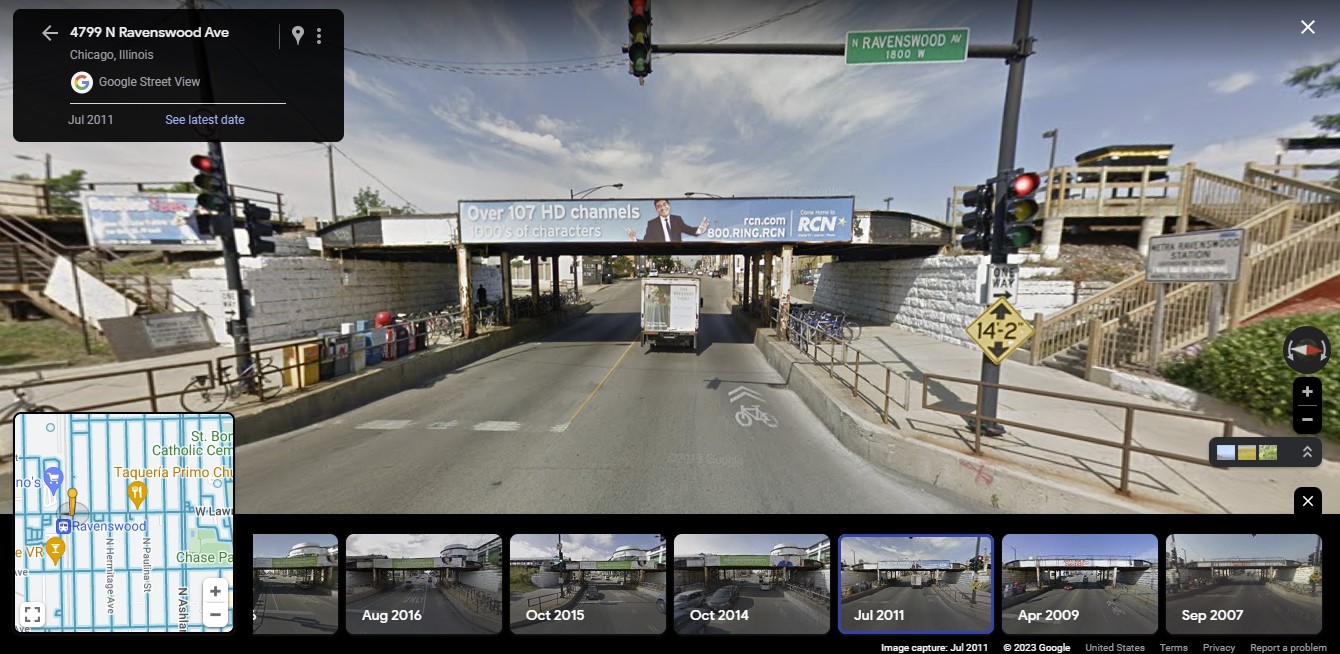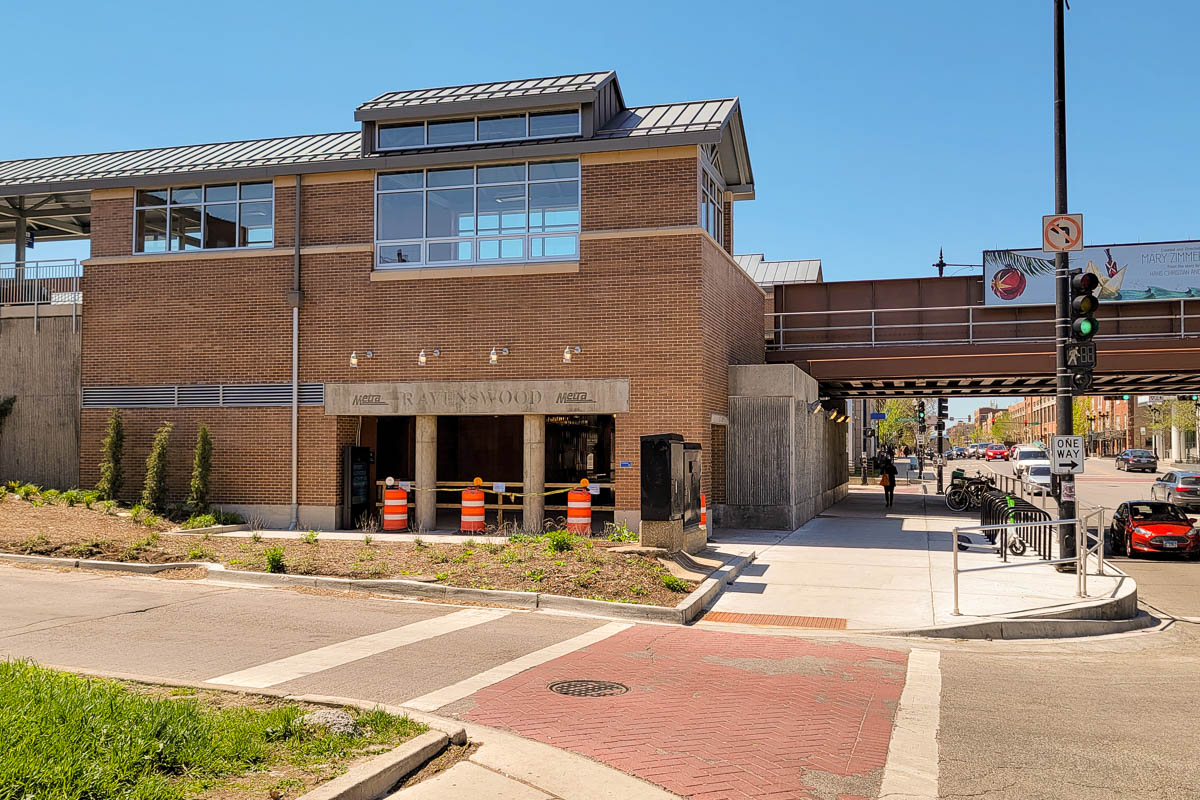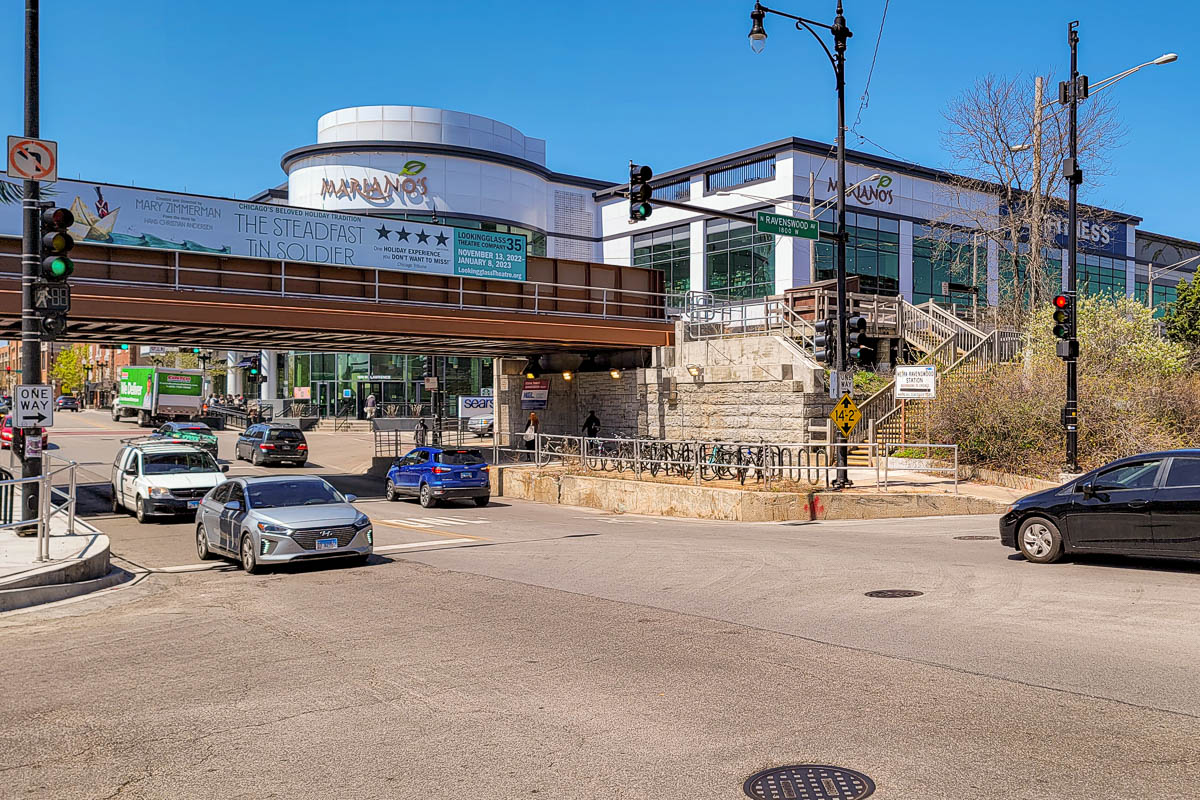I got an update today from Metra about the Ravenswood Union Pacific North station, after sending an inquiry last week. Before I get to that, let's take a look at photographic evidence that we've had to use the "temporary" platform north of Lawrence Avenue for just under 12 years now:

That's the Google Street View from July 2011 showing that Metra has already closed the 1950s-era inbound platform (on the left) and opened the "temporary" platform (on the right).
I took these two photos a week ago, but I could have taken them last September with only one minor change (the new "temporary" fence by the entrance to the new platform):


OK, so now that we've established that (a) we haven't had even a semi-permanent inbound platform since the middle of President Obama's first term, and (b) neither Metra nor the UPRR has done any noticeable work on the new new-but-unfinished platform since I last posted news seven months ago, here is what a Metra spokesperson told me this afternoon:
Per our station project Construction Team, a late July 2023 completion is anticipated. There are a few items remaining that need to be addressed to complete the project.
- Structural tiles, which the manufacturer has delayed delivery of. Our Team has 3 other options to address this issue that they are looking into and are actively progressing a tile alternative.
- The waterproofing along the edge of the platform and the bridge abutment (Lawrence & Leland) that requires the removal of track and ballast by Union Pacific Railroad will be scheduled by UP forces. Ballast work could not be performed during winter months when ground is frozen.
- Guardrail fencing change work at Leland Bridge is proceeding through redesign to accommodate a conduit system. Contractor estimates work end of May/early June.
- A solution to the hairline cracks in the platform surface has been determined. A coating to address this issue cannot be applied until weather conditions permit.
- Additional CDOT crossing work required along with the asphalt overlay patching in the street cannot occur until the asphalt plants reopen next month.
With a project of this magnitude that entailed the replacement of 22 bridges on the UPN Line, as well as a complete station project, its impact on the community was/is unavoidable and cannot be understated. Metra is making every attempt possible to improve the dates on the remaining items and complete the work, as soon as possible.
I knew about #3, and previously reported about #1. The rest just frustrates me to no end.
The UPRR and Metra should have completed this project in 2018. I will remind everyone that four years of the delay happened because former Illinois governor Bruce Rauner (R) cut funding to everything based solely on his extreme anti-government ideology. (Makes you wonder why he wanted to govern, right?) And once again, I will remind everyone that if I had the power, I would sentence the former governor to stand on the platform for two hours a day, every day, for a duration equal to the entire delay to the project that he caused. Even that sentence seems lenient.
I hope that my contact at Metra has accurate information, because I'm really tired of standing in the rain just 20 meters from what appears to be a perfectly serviceable but inaccessible shelter.
WBEZ reporter Michael Gerstein went out to the IKEA in Schaumburg, Ill., to test our transit system and its navigation apps. It went fine, but Gerstein had an unusual experience:
Major construction projects have snarled the Kennedy Expressway and the Blue Line’s weekend service, so my editor sent me on a 29-mile odyssey to Schaumburg. The idea was to test how Chicago’s regional transit agencies (CTA, PACE, Metra) work with each other and how many apps, trackers and planning devices I’d need to use to get there.
We were trying to see firsthand how accurate the region’s tracking technology is and why apps often promise buses and trains that don’t show up when they’re supposed to. All this comes at a time when public officials are encouraging more drivers to take public transit to and from downtown.
My two-hour sojourn to IKEA was unremarkable and pretty much on time (barring some initial inaccurate estimates from every app I tried except the city’s Ventra app). Still, other riders have experienced inaccuracies with trackers, and it’s hard to get to the bottom of why. In a recent WBEZ survey of nearly 2,000 CTA riders, about 9 in 10 survey takers said they’d experienced a delay taking a bus or train in the past 30 days.
Chicago, which used to be a leader in transit technology, now has some catching up to do with the broader tech world. “Our train and bus tracker were among the first tools of its time among any U.S. transit agency,” Brian Steele, CTA’s chief spokesman, said in an interview. But predictive algorithms have evolved, Steele acknowledged, and Chicago needs an upgrade that would give it the ability to automatically update the position of a bus that goes off a route or a train that falls behind.
Real-time information is only available after a train or bus leaves the terminal – and only if that bus or train is on its scheduled route, Steele said.
I also learned that I really don’t like being in IKEA. Some people prefer navigating a maze-like furniture store where you can’t find anything, that’s about 5 degrees too warm, and where every aisle and bathroom stall is packed.
I do like living 400 meters from the Metra station that takes me to downtown Chicago in 14 minutes, though. From dropping Cassie at doggy day care to sitting at my desk, my commute usually takes about 30-35 minutes. I would not take any job that had me drive out to the suburbs again, unless they paid me for travel time.
The City of Lights has done a mitzvah for its citroyens, essentially banning cars from the city center in part by providing real alternatives:
French planners got a later start than their American counterparts. Before Paris could be carved up by expressways, resistance mounted over the familiar objections that also characterized highway revolts in the United States: destruction, displacement, pollution, the oil crisis. These protests were nested in a trio of nascent trends: the rise of environmentalism, the historic preservation movement, and the early waves of gentrification.
By the 1990s, anti-car forces were playing offense. In 1996 came Paris Breathes, a series of periodic street closures on Sundays and holidays. In 1998 the city opened Métro Line 14—the first new subway in more than 60 years, and the first of a blitz of transit investments concentrated in and around the suburbs. In 2007 the city rolled out the bike-share program Vélib’, which now offers 20,000 bicycles over 1,400 stations in and around the city. Car ownership in the region peaked in 1990 and has been declining since, even as the metro area population has grown by 10 percent.
Hidalgo’s Green Party deputy mayor for transportation, David Belliard, is even more strident: “The redistribution of public space is a policy of social redistribution,” he told me in 2021. “Fifty percent of public space is occupied by private cars, which are used mostly by the richest, and mostly by men, because it’s mostly men who drive, and so in total, the richest men are using half the public space. So if we give the space to walking, biking, and public transit, you give back public space to the categories of people who today are deprived.”
A top official in New York or Chicago would never. But in Paris, this is how City Hall talks.
Sad but true. I mean, it's taken us 13 years to replace a single Metra station, for example. I believe we'll see a car ban from the Loop someday, and I hope I'm still alive when it happens.
Once again, I have too much to read:
Finally, it was 20 years ago tonight that Chicago Mayor Richard M. Daley had city workers vandalize Meigs Field so that he could sell the land to his pals. The Tribune has a photo history.
Here's why your suburb will go bankrupt in 25 years if it doesn't start building a denser environment:
Really, it's arithmetic. And you can generalize this principle to understand why building new highways instead of fixing old ones makes no financial sense. But that's old news.
I've had a bunch of tasks and a mid-afternoon meeting, so I didn't get a chance to read all of these yet:
Finally, close to me, after the lovely Grafton Pub closed last August, the Old Town School of Folk Music stepped in to buy the space. But that plan has hit a snag after a higher bidder emerged.
After having the 4th-mildest winter in 70 years, the weather hasn't really changed. Abnormally-warm February temperatures have hung around to become abnormally-cool March temperatures. I'm ready for real spring, thank you.
Meanwhile...
- ProPublica reports on the bafflement inside the New York City Council about how to stop paying multi-million-dollar settlements when the NYPD violates people's civil rights—a problem we have in Chicago, for identical reasons—but haven't figured out that police oversight might help. (One Daily Parker reader suggested taking the money out of the police pension fund.)
- A bill moving through Florida's legislature would address suburban sprawl by redefining it. (Want to bet a real-estate developer lobbied for this one?)
- A ransomware attack a few weeks ago has affected up to 130 organizations, according to researchers and online boasts from the attackers.
- United Airlines wants to start air-taxi service between the Loop and O'Hare by 2025, using electric vertical take-off and landing (eVTOL) airplanes.
Finally, I laughed out loud at the YouGov survey that found 46% of American men who have never flown an airplane think they could land an air transport with only some help from Air Traffic Control. I laughed because I do know how to fly a plane, and I don't think I could land a 787 well enough to use the plane again under any circumstances without a few dozen simulator hours. In fact, I would probably spend several crucial minutes trying to figure out how to change the radio to 121.5 and the transponder to 7700. But hey, the United States put Dunning and Kruger on the map, so this seems about right to me.
I'm arguing with the Blazorise framework right now because their documentation on how to make a layout work doesn't actually work. Because this requires repeated build/test cycles, I have almost no time to read all of this:
Finally, a group of Chicago aldermen have proposed that the city clear sidewalks of snow and ice when property owners don't. Apparently the $500 fines, which don't happen often, don't work often either.
The storm predicted to drop 100 mm of snow on Chicago yesterday missed us completely. That made my Brews & Choos research a lot more pleasant, though I did tromp all over the place in heavy boots that I apparently didn't need. Of course, had I not worn them, I would now be writing about my cold, wet socks.
So while I'm getting two reviews together for later this week, go ahead and read this:
Finally, author John Scalzi celebrates the 25th anniversary of his domain name scalzi.com, exactly one month before I registered my own. But as I will point out again in a couple of posts later this spring, The Daily Parker started (as braverman.org) well before his blog. Still, 25 years is a long time for a domain to have a single owner.
At my day job, we just ended our 80th sprint on the project, with a lot of small but useful features that will make our side of the app easier to maintain. I like productive days like this. I even voted! And now I will rest on my laurels for a bit and read these stories:
Finally, the European Space Agency wants to establish a standard time zone for the moon. Since one day on the moon is 29.4 days here, I don't quite know what that will look like.